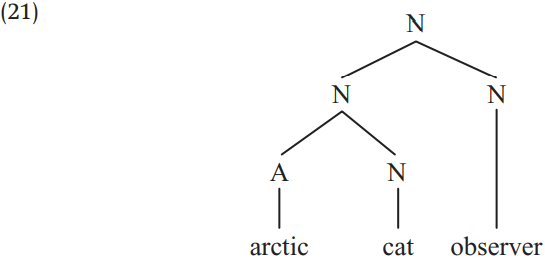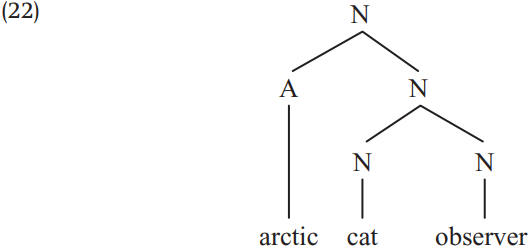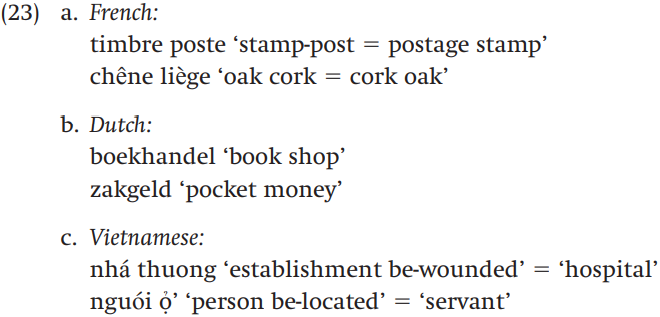


 Grammar
Grammar
 Tenses
Tenses
 Present
Present
 Past
Past
 Future
Future
 Parts Of Speech
Parts Of Speech
 Nouns
Nouns
 Verbs
Verbs
 Adverbs
Adverbs
 Adjectives
Adjectives
 Pronouns
Pronouns
 Pre Position
Pre Position
 Preposition by function
Preposition by function 
 Preposition by construction
Preposition by construction
 Conjunctions
Conjunctions
 Interjections
Interjections
 Grammar Rules
Grammar Rules
 Linguistics
Linguistics
 Semantics
Semantics
 Pragmatics
Pragmatics
 Reading Comprehension
Reading Comprehension|
Read More
Date: 2024-02-05
Date: 2023-08-16
Date: 2023-06-01
|
We can look at compounds as having internal structure in precisely the same way that derived words do, and we can represent that structure in the form of word trees. The compounds windmill and hard hat would have the structures in (19):

Compounds, of course, need not be limited to two bases. Compounding is what is called a recursive process, in the sense that a compound of two bases can be compounded with another base, and this compounded with still another base, so that we can eventually obtain very complex compounds like paper towel dispenser factory building committee report. As with derived words, it is possible to show the internal structure of complex compounds using word trees. Assuming that this compound is meant to denote a report from the building committee for the paper towel dispenser factory, we might give it the structure in (20):

Some compounds can be ambiguous, and therefore can be represented by more than one structure For example, the compound arctic cat observer, might have this structure:

The way we’ve drawn this tree, the compound arctic cat has been compounded with the noun observer to make a complex compound. The compound as a whole then must mean ‘an observer of arctic cats’. But if the compound arctic cat observer were intended to mean ‘a cat observer who likes to do her observations in the arctic’, the structure of the tree would be that in (22), where cat observer is first compounded, and then arctic added in :

Often, the more complex the compound is, the greater the possibility of multiple interpretations, and therefore multiple structures.
Languages other than English frequently construct compounds on free bases just as English does, although we can see in the French and Vietnamese examples in (23) that the order of elements in the compound is sometimes different from that in English :

As we saw above, English has bound bases as well as free bases, and when we put two of them together, as in the examples in (24), we might call these forms compounds as well. Some linguists call them neo-classical compounds, as the bound bases usually derive from Greek and Latin:

In languages like Latin where, as we saw, word formation often operates on roots or stems, rather than on free forms, all compounds are formed from bound bases. Specifically, the first parts of the compounds in (25) are formed from the roots of the nouns ala ‘wing’ and capra ‘goat’, (respectively al- and capr-) plus a vowel -i- linking the two parts of the compound together:

The -i- that occurs between the two roots has no meaning, and is not the vowel that usually precedes the inflections (for these two nouns, that vowel would be -a). It is there solely to link the parts of the compound together, and is therefore sometimes called a linking element or alternatively an interfix (the latter term is less common).
|
|
|
|
5 علامات تحذيرية قد تدل على "مشكل خطير" في الكبد
|
|
|
|
|
|
|
تستخدم لأول مرة... مستشفى الإمام زين العابدين (ع) التابع للعتبة الحسينية يعتمد تقنيات حديثة في تثبيت الكسور المعقدة
|
|
|